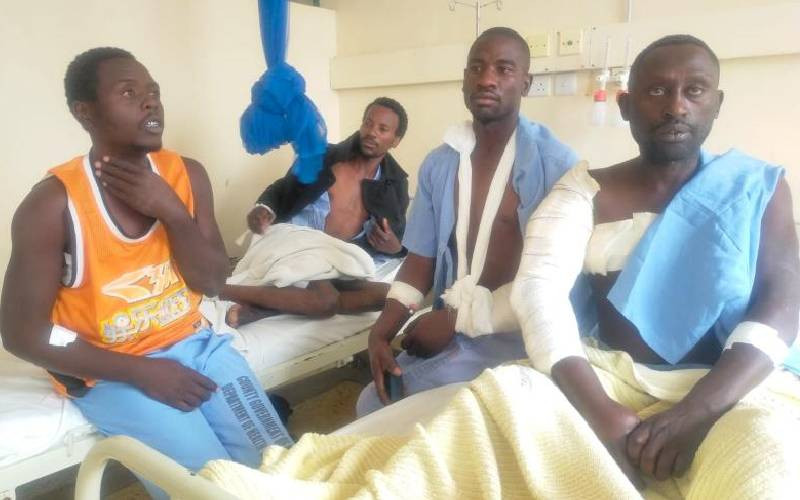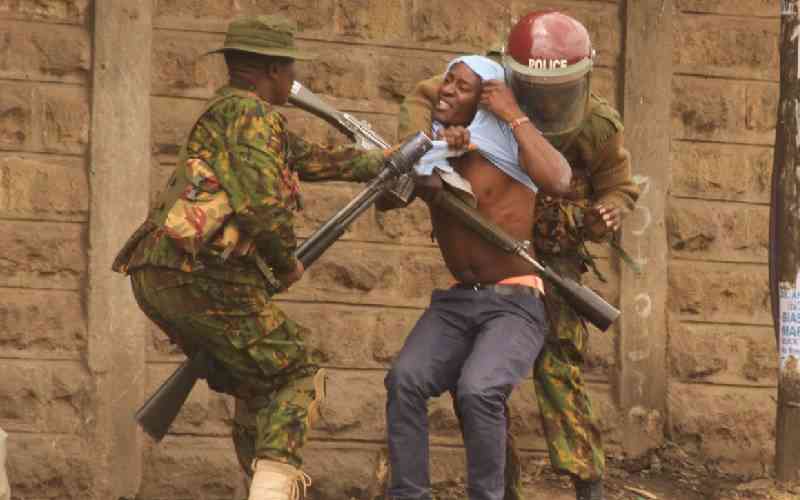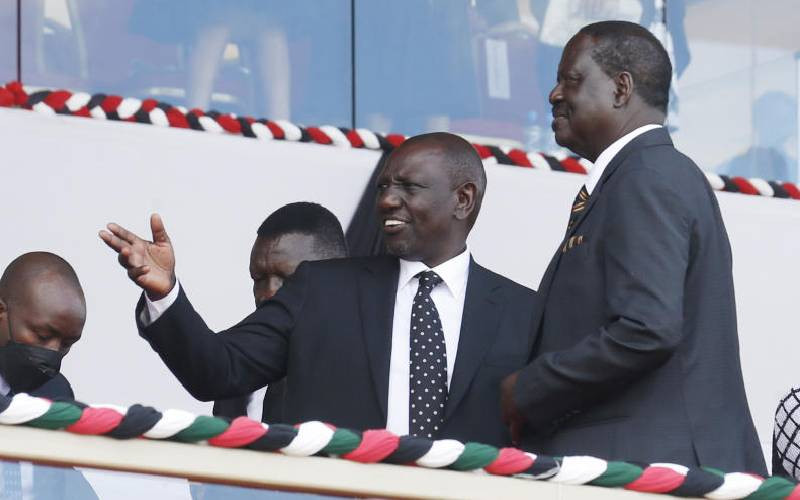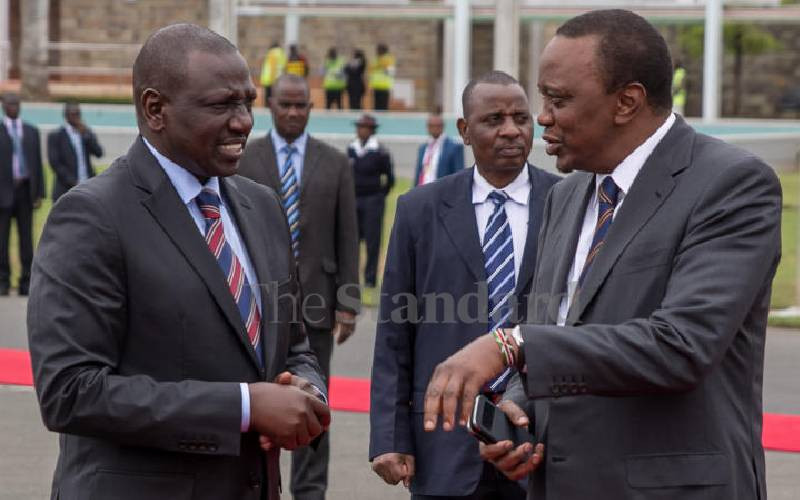How UDA action snuffed the life out of demos in the grassroots
The first day of the three-day anti-government protests called by Azimio la Umoja last Wednesday seems to have rattled the Kenya Kwanza administration.
In Nairobi, Kisumu, Kisii, Migori and Nakuru, the protests turned ugly as protesters clashed with police, resulting in deaths, destruction of property and looting.
In a meeting at State House, Nairobi, last Monday, President Ruto rallied his Kenya Kwanza troops to counter the protests by organising meetings and rallies in their backyards, ostensibly to remove the sting from the demos at a time many Kenyans were enraged by the high cost of living and high taxation.
The strategy, to some extent, seems to have had an effect in some regions of the country.
In Western, when he was arrested and released a week before the Azimio demonstrations, ODM deputy party boss Wycliffe Oparanya vowed to lead landmark demos in Kakamega town and the larger Western region.
- .
Keep Reading
- What Kenya needs is not 'nusu mkate' but permanent political settlement
- Why Kenya now needs to exhale
- Epic showdown looms as Ruto goes for Uhuru over protests
- Why Kenya urgently needs power of reconciliation, honest dialogue
But as fate would have it, the vow was just that, as Oparanya went missing, leaving wananchi to their own devices even as UDA Secretary General Cleophas Malala and a host of other Members of the County Assembly vowed to counter them.
“I feel the pain of the recently enacted Finance Act 2023, which EPRA has already started implementing against a court directive. I wanted to go to the streets to demonstrate against that but I didn’t after being approached by pro-government operatives,” said Jacob Barasa, a boda boda operator in the town.
The Sunday Standard gathered that pro-government agents led by Malala simply activated their grassroots networks to silence protesters in Kakamega town and several other parts of the county.

The grassroots mobilisers then applied the general 48 Laws of Power in Robert Greene’s seminal book to win them over through seduction, charm and deception.
“We first of all admitted to them that the cost of living was high and pleaded with them not to go to the streets as we were working on the mess, they had doubts but later bought the narrative,” said a source.
At least 300 people gathered behind a supermarket in Kakamega town, some 200 metres from Kakamega Central Police Station, to proclaim peace.
It was instructive that the Thursday meeting was never disrupted, yet police had earlier warned against ‘illegal’ assemblies.
On day one of the demos on Wednesday, Malala demanded that residents keep the peace as there was no reason to demonstrate, warning senators Godfrey Osotsi (Vihiga) and Edwin Sifuna (Nairobi) to keep off the town.
The strategy worked well on Wednesday and on Thursday, Malala would emerge again, this time to appeal for dialogue between Azimio and Kenya Kwanza.
Even as Kakamega managed some relative peace, with only Lugari experiencing pockets of riots, chaos reigned in Busia.
Busia Governor Paul Otuoma and his Kakamega counterpart, Fernandes Barasa, have at best been lukewarm on the demos, another element that UDA capitalised on to neutralise the opposition protests.
In Nakuru, the protests seem to have fizzled out after the first day.
Although ODM leader Raila Odinga termed the Wednesday protests as ‘largely successful’, protesters were a no-show on the streets of Nakuru on Thursday and Friday.
Security apparatus had been mobilised from different parts of the county to focus on Nakuru Town West, which has been the centre of anti-government protests for the past two weeks.
On Thursday morning, a section of youth attempted to block a major road connecting Nakuru Town West and the city centre but their plot was thwarted by a contingent of police officers.
For the rest of the day, no protesters or gatherings were seen on the streets, save for pockets of youth observing and discussing the situation away from the police.
But what may have foiled the opposition’s plan for sustained three-day protests?
Nakuru Town West MP David Gikaria says that apart from the police deployment, there was a political hand in stopping the protests from spilling over to the second and third days.
“We were to issue a joint statement as Nakuru leaders. My colleagues, especially the MPs, are in their constituencies monitoring the situation and sensitising their people on the importance of peace and security,” said Gikaria.
The UDA MP was speaking to the press in his constituency after addressing youth whom he urged not to be drawn into the protests.
He said that he was engaging his Nakuru West counterpart Samuel Arama to ensure that order is restored.

Mr Gikaria said the protests witnessed in the neighboring constituency were not because of the high cost of living but purely criminal.
“Looting and robberies have been pronounced more than the actual protests. If it is the cost of living, the price of commodities especially farm produce has drastically dropped after the first harvest was made,” he said.
As this happened, Former Bahati MP Kimani Ngunjiri visited Nakuru Town West accompanied by local leaders where he engaged the residents on the adverse effects of the protests.
“It is sad that people are breaking into homes and looting everything including clothes and food. If Raila Odinga is not aware, I am now telling him that people are hiding behind his call for protests to execute robberies,” said Mr Ngunjiri.
The former legislator warned the youth that their conduct was likely to plunge the country into chaos that would have regrettable consequences.
“The people of Nakuru West where the protests happened have confessed to seeing many new faces leading the protests. Whoever is behind their coming should be stopped immediately,” said Mr Ngunjiri.
While calling on President Ruto and government agencies to exercise their powers, Mr Ngunjiri said nobody involved in crime should be spared.
Speaking separately, Nakuru Town West MP Samuel Arama said that he was aware of some leaders sponsoring chaos in his constituency.
The leaders have warned that if the opposition does not cease the protests, they too would organise counter-protests, especially in areas where businesses were at risk.
At the Coast, the decision by Azimio to devolve its anti-government protests exposed a lack of leadership and collective responsibility among opposition leaders in the region.
Governors elected on ODM tickets, Abdulswamad Nassir (Mombasa), Gideon Mung’aro (Kilifi) and Tana River’s Samuel Godhana gave the protests a wide berth.
Political analysts say the proponents of the anti-government protests lost to the forces of the state, and the ruling United Democratic Alliance (UDA) plans due to their poor organisational structure.
But ODM leaders interviewed claimed that they feared that an escalation of the protests would have eroded gains made in the fragile tourism sector, smarting from Covid-19 effects and jitters of the 2022 election.
The county chiefs instead left the protests in the hands of some civil society organisations and elected leaders, with the former publicly complaining of being betrayed by the political class.
A political analyst, Ms Maimuna Mwidau, noted there was a lack of collective leadership on the part of Azimio in the Coast region to steer the demos after governors took a backseat.
“The governors seem to have looked at the potential threats to the economies of their counties and decided not to lead the demonstrations.
“Also, many people decided not to participate because they thought it would make the situation more difficult as the economies of the counties relied on the tourist sector, port or transport, which faced the threat of disruption,” she argued.
She observed that residents appeared to prefer dialogueas they feared that a total lockdown would instead result in higher cost of living.
Lawyer Abubakar Yusuf observed that there was a divided voice in organising protests in Coast.
“Many residents did not participate, perhaps because they do not believe protests will offer a solution to the high cost of living. Some believe protests in this country are also used to settle political scores instead,” he noted.
Separately, Ms Maimuna and Mr Yusuf observed that UDA meetings in various parts of Mombasa by national Vice Chairman Hassan Omar to counter the demonstrations served to show that Kenyans did not support the protests.
Although the UDA meetings by Omar appeared to be well organised and led, it was the use of force by the police that helped clamp down on demonstrators.
“When UDA called MPs to a meeting in Nairobi and asked them to counter the demonstrations, leaders went to talk to their people as a way of showing that Kenyans do not support the Azimio protests. To me, what was the police action on protesters,” said Mr Yusuf.
In Mombasa, politicians stayed put in boardrooms and left civil society to play hide and seek with the police in the streets. Mombasa Senator Mohamed Faki said they were monitoring the situation and preparing to bail out arrested youth.
“We are monitoring the situation and strategising. We will intervene and ensure those arrested are released. So far so good,” said Faki. BY THE STANDARD MEDIA












Post a Comment